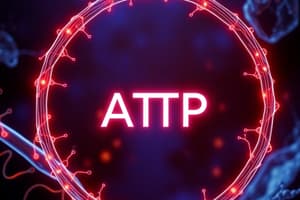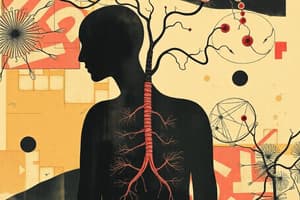Podcast
Questions and Answers
Which statement correctly describes the relationship between photosynthesis and cellular respiration?
Which statement correctly describes the relationship between photosynthesis and cellular respiration?
- Both processes occur exclusively in the mitochondria of eukaryotic cells.
- Both processes use the same reactants and products.
- Photosynthesis breaks down glucose to produce ATP, while cellular respiration creates glucose.
- Photosynthesis creates glucose, while cellular respiration breaks down glucose to produce ATP. (correct)
During which stage of cellular respiration is carbon dioxide released?
During which stage of cellular respiration is carbon dioxide released?
- Intermediate Step and Krebs Cycle (correct)
- Chemiosmosis
- Glycolysis
- Electron Transport Chain
What is the primary role of NADH and FADH2 in aerobic cellular respiration?
What is the primary role of NADH and FADH2 in aerobic cellular respiration?
- To transport electrons to the electron transport chain (correct)
- To serve as the final electron acceptor in the electron transport chain
- To directly produce ATP molecules in the mitochondrial matrix
- To break down glucose into pyruvate
Which of the following processes occurs in the inner mitochondrial membrane?
Which of the following processes occurs in the inner mitochondrial membrane?
How does cyanide inhibit ATP production?
How does cyanide inhibit ATP production?
Which process generates the most ATP molecules during cellular respiration?
Which process generates the most ATP molecules during cellular respiration?
In the absence of oxygen, some cells resort to fermentation. What is the primary purpose of fermentation?
In the absence of oxygen, some cells resort to fermentation. What is the primary purpose of fermentation?
Which of the following is NOT a product of the Krebs cycle?
Which of the following is NOT a product of the Krebs cycle?
Why is ATP considered the energy currency of the cell?
Why is ATP considered the energy currency of the cell?
If a drug prevents the movement of pyruvate into the mitochondria, which processes would be directly inhibited?
If a drug prevents the movement of pyruvate into the mitochondria, which processes would be directly inhibited?
Flashcards
What is ATP?
What is ATP?
The energy currency essential for cellular function, composed of adenosine and three phosphate groups.
Cellular Respiration
Cellular Respiration
A crucial metabolic process that breaks down glucose to produce ATP, primarily in the mitochondria of eukaryotic cells.
Glycolysis
Glycolysis
The initial stage of cellular respiration where glucose is broken down into pyruvate, yielding a small amount of ATP and NADH.
Intermediate Step (Cellular Respiration)
Intermediate Step (Cellular Respiration)
Signup and view all the flashcards
Krebs Cycle
Krebs Cycle
Signup and view all the flashcards
Electron Transport Chain
Electron Transport Chain
Signup and view all the flashcards
Chemiosmosis
Chemiosmosis
Signup and view all the flashcards
Fermentation
Fermentation
Signup and view all the flashcards
Oxygen's Role in ETC
Oxygen's Role in ETC
Signup and view all the flashcards
Effect of Cyanide
Effect of Cyanide
Signup and view all the flashcards
Study Notes
ATP and Cellular Function
- Cells constantly perform cellular processes, including active transport, necessitating a continuous energy supply.
- ATP or adenosine triphosphate is the energy currency essential for cellular function.
- ATP is a type of nucleotide composed of adenosine and three phosphate groups.
Cellular Respiration Overview
- ATP production is vital for all cells, whether prokaryotic or eukaryotic.
- Cellular respiration is a key process for ATP synthesis, especially in eukaryotic cells.
- Eukaryotic cells contain membrane-bound organelles like the nucleus and mitochondria, found in protists, fungi, animals, and plants.
- Mitochondria, present in most eukaryotic cells, play a crucial role in aerobic cellular respiration.
Aerobic Cellular Respiration Equation
- Reactants in cellular respiration are on the left side of the equation, while products are on the right.
- The equation for cellular respiration is similar to that of photosynthesis, but with reversed reactants and products.
- Photosynthesis creates glucose, while cellular respiration breaks down glucose to produce ATP.
Glycolysis
- Glycolysis occurs in the cytoplasm and does not require oxygen which makes it anaerobic.
- Glucose is converted into a usable form called pyruvate in glycolysis.
- Glycolysis has a net yield of two pyruvate molecules, two ATP molecules, and two NADH molecules.
- NADH is a coenzyme that transports electrons, which is important for later ATP production.
Intermediate Step
- Two pyruvate molecules are transported into the mitochondrial matrix via active transport.
- Pyruvate is oxidized in the mitochondria and converted into two molecules of acetyl-CoA, which will be used in the next step.
- Carbon dioxide is released, and two NADH molecules are produced during this step.
Krebs Cycle
- The Krebs cycle, also known as the citric acid cycle, takes place in the mitochondrial matrix and is an aerobic process.
- The cycle doesn't directly use oxygen, but some events in the cycle require oxygen to proceed.
- Acetyl-CoA molecules enter the cycle, carbon dioxide is released, and 2 ATP, 6 NADH, and 2 FADH2 molecules are produced.
- FADH2, like NADH, is a coenzyme that aids in electron transport for ATP synthesis.
Electron Transport Chain and Chemiosmosis
- In eukaryotic cells, the electron transport chain and chemiosmosis occur in the inner mitochondrial membrane and require oxygen.
- Electrons are transferred from NADH and FADH2 to protein complexes and electron carriers, generating a proton gradient by pumping protons across the inner membrane.
- Protons accumulate in the intermembrane space, creating an electrochemical gradient.
- Protons move down the electrochemical gradient through ATP synthase, powering ATP production by adding a phosphate to ADP.
- Oxygen serves as the final electron acceptor, combining with hydrogen ions to form water (H2O).
ATP Production Yield
- The electron transport chain and chemiosmosis produce significantly more ATP than the previous two steps.
- ATP production ranges from 26 to 34 ATP molecules per glucose molecule via electron transport chain and chemiosmosis.
- The total ATP yield from all three steps (glycolysis, Krebs cycle, and electron transport chain) is estimated to be between 30 and 38 ATP molecules per glucose molecule.
Fermentation as an Alternative
- Some cells can perform fermentation when oxygen is unavailable, although it is less efficient than aerobic cellular respiration.
- Fermentation allows ATP production in the absence of oxygen.
Importance of ATP Production and Mitochondrial Diseases
- ATP production is essential for cellular survival, and its disruption can be lethal.
- Cyanide inhibits electron transport, preventing ATP production.
- Mitochondrial diseases are an area of increasing research due to the critical role mitochondria play in ATP production.
Studying That Suits You
Use AI to generate personalized quizzes and flashcards to suit your learning preferences.




